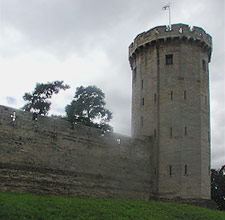 |
Bland, not Grand |

 Artillery
forts were strong enough to take cannon fire, large enough to
hold a garrison of soldiers (and perhaps also encompass a town), and
each one spread out far beyond what any medieval castle would
require for ground. But as suggested in the computer simulation
above, in profile and from a distance those forts
were not awe-inspiring nor even stirring to the eye. As anyone outside standing in a
field would see it, a fort tended to resemble the back side of a
dike. The first impression for a modern person would be "oh, a
railroad embankment."
Artillery
forts were strong enough to take cannon fire, large enough to
hold a garrison of soldiers (and perhaps also encompass a town), and
each one spread out far beyond what any medieval castle would
require for ground. But as suggested in the computer simulation
above, in profile and from a distance those forts
were not awe-inspiring nor even stirring to the eye. As anyone outside standing in a
field would see it, a fort tended to resemble the back side of a
dike. The first impression for a modern person would be "oh, a
railroad embankment."
With its daring vertical walls and high towers, a medieval fortification gripped the heart. An artillery fort did not inspire with its sloped sides on a low and broad shape.
Only when one came close did an artillery fort command respect.
This brings us to the next chapter: Beyond the Basics. Artillery fortresses that went up
across Europe were
either all earth or an earth core faced and reinforced with
masonry. Masonry made a sturdy, weather resistant, but costly enhancement.
| Back |
Limits to Earth Forts |
|
|
|